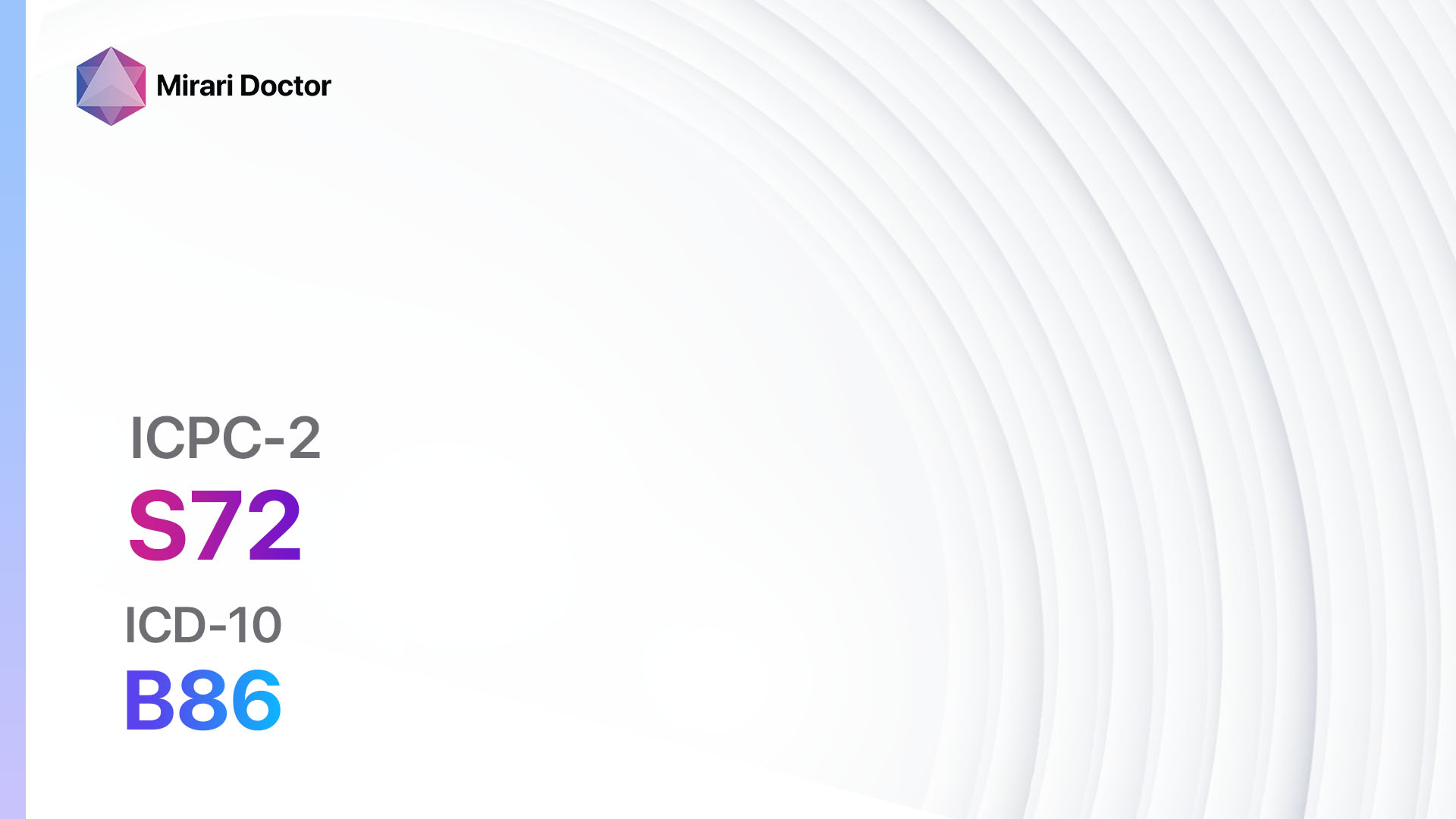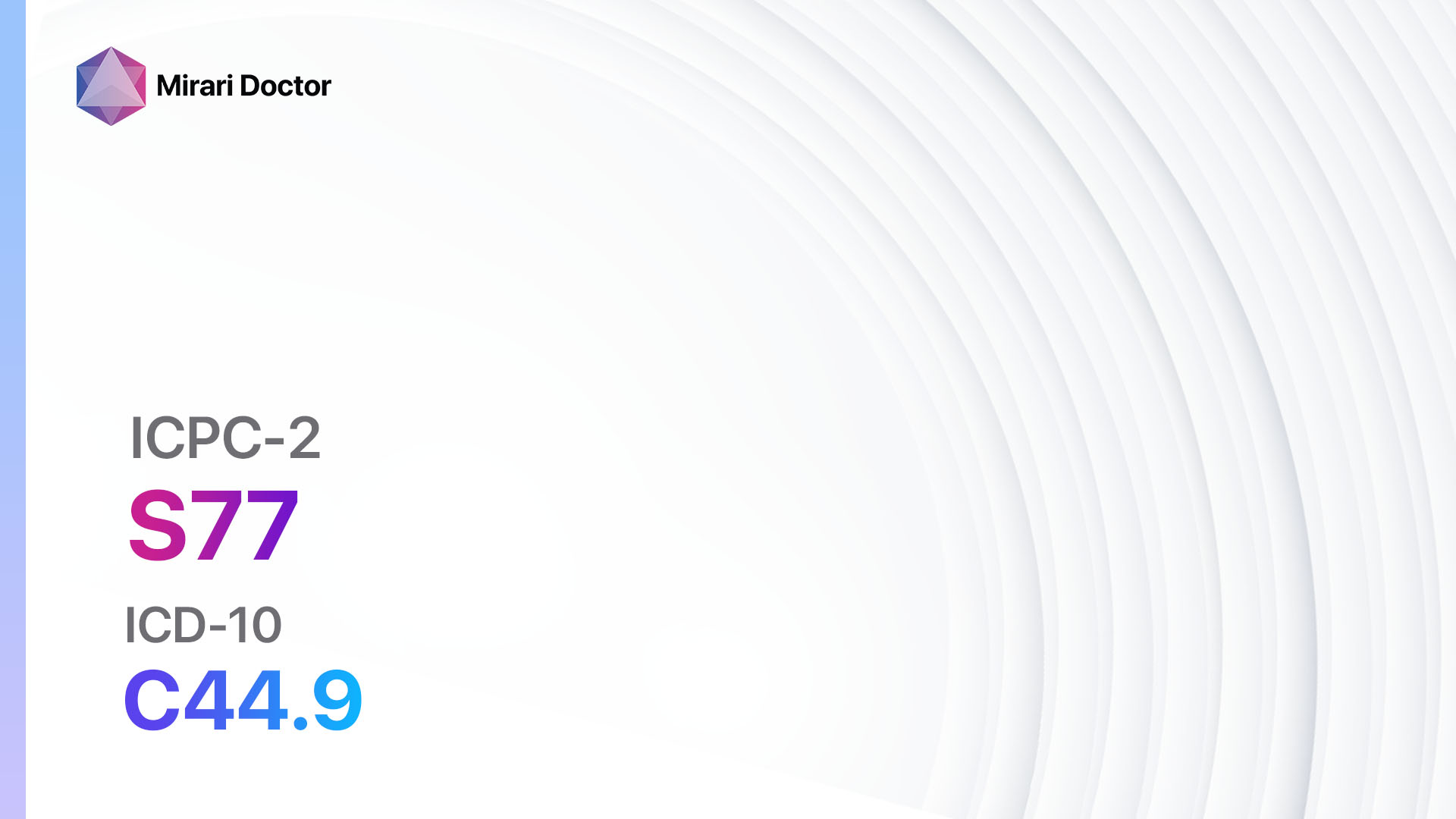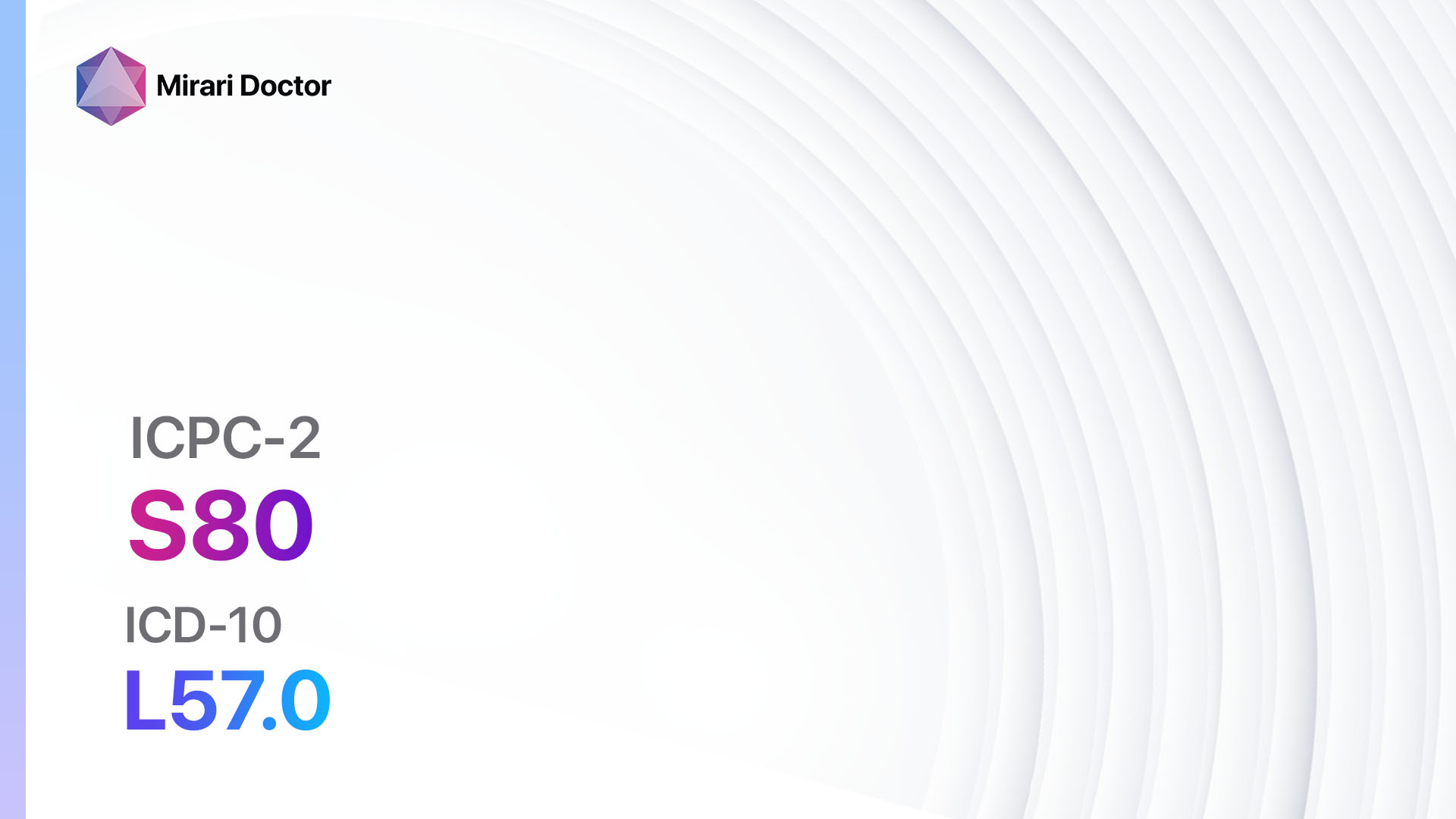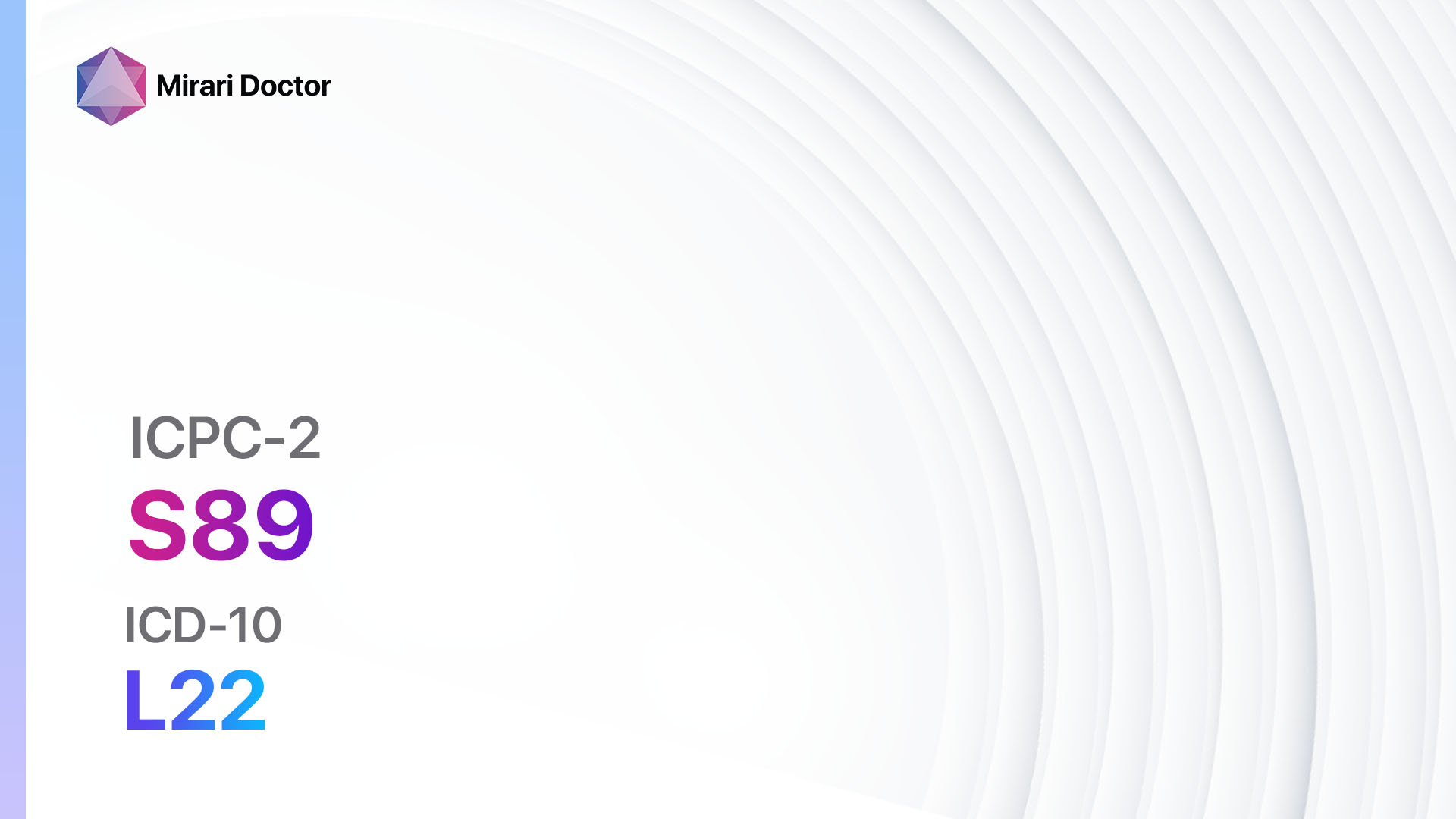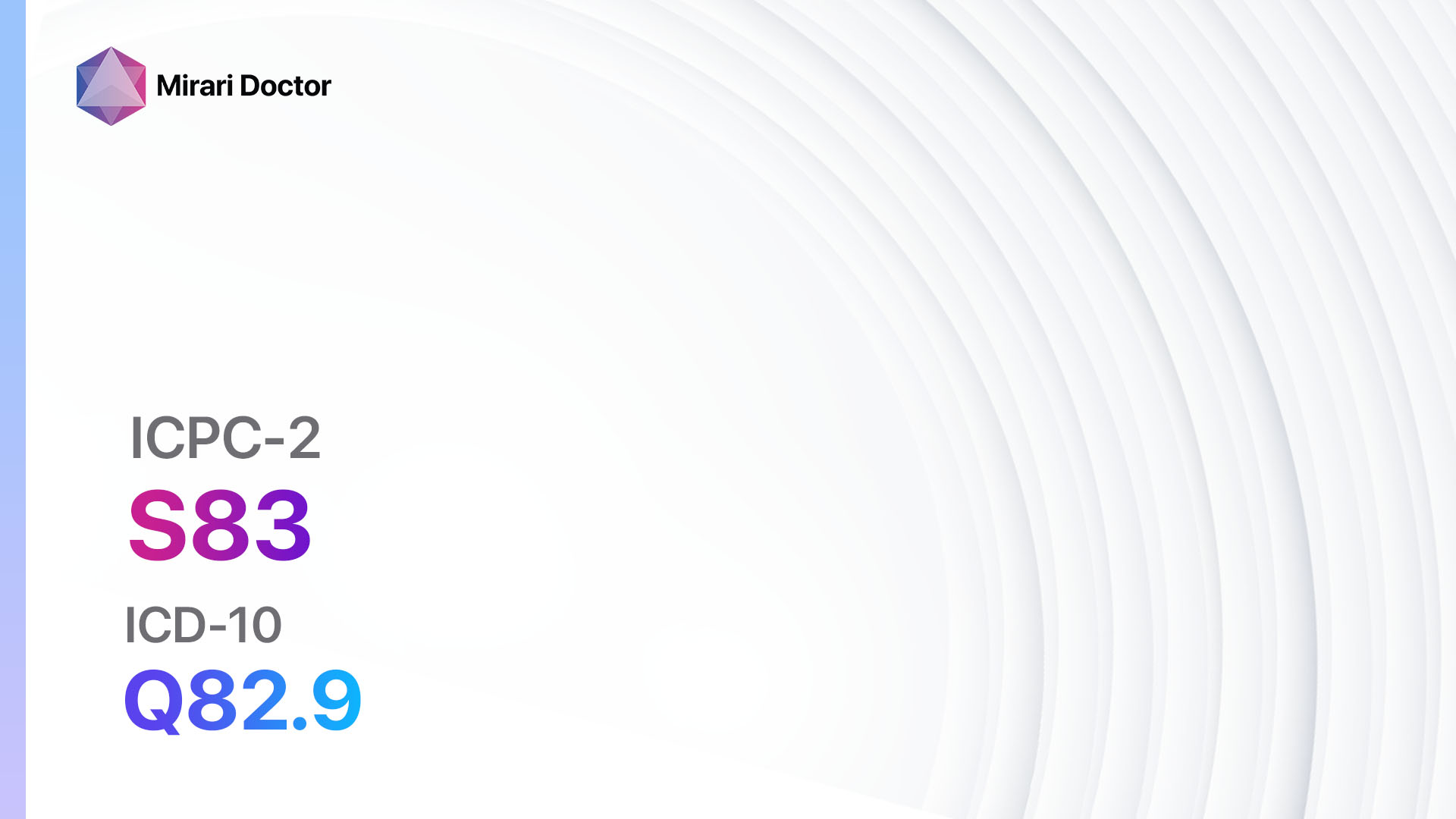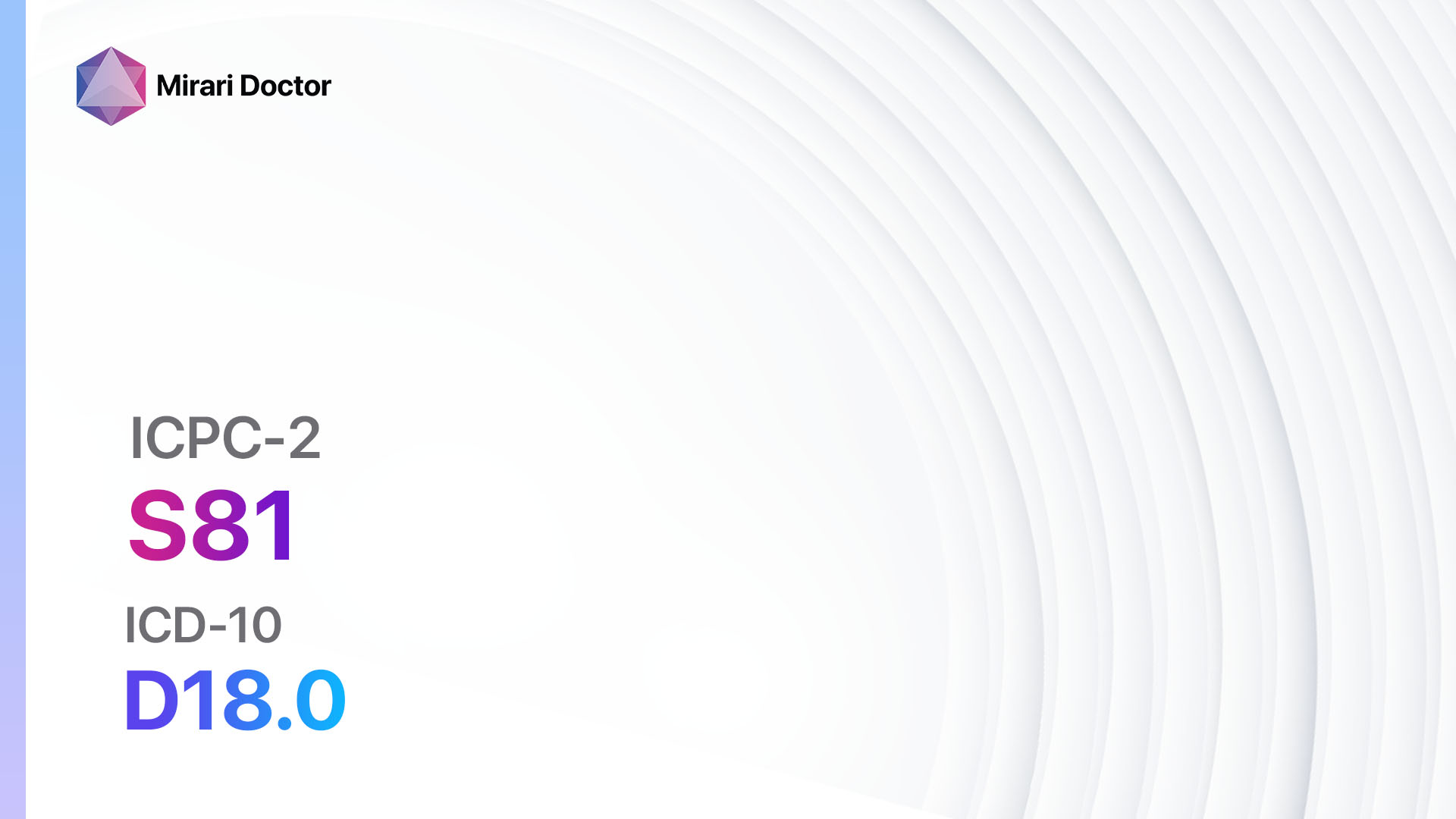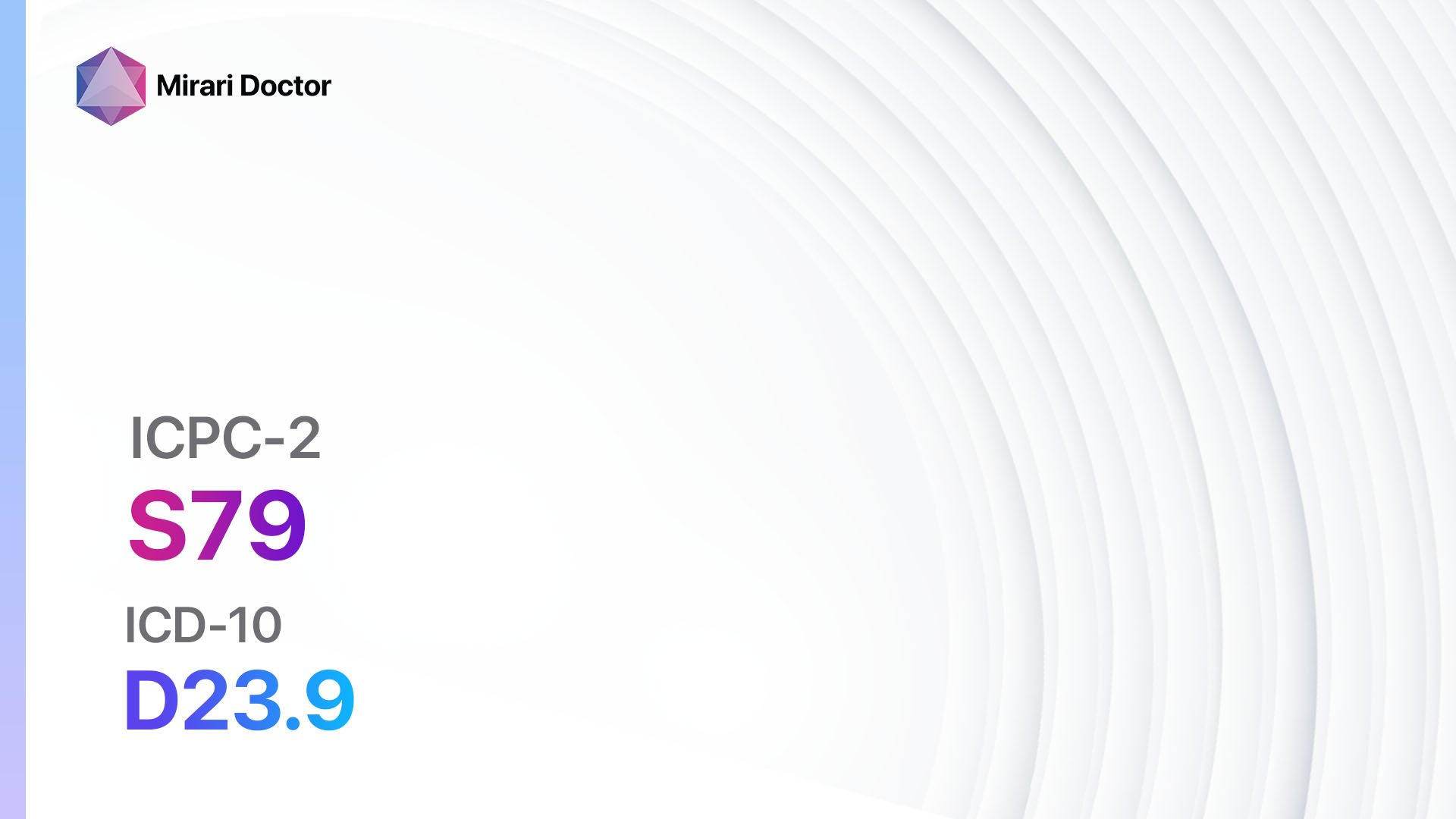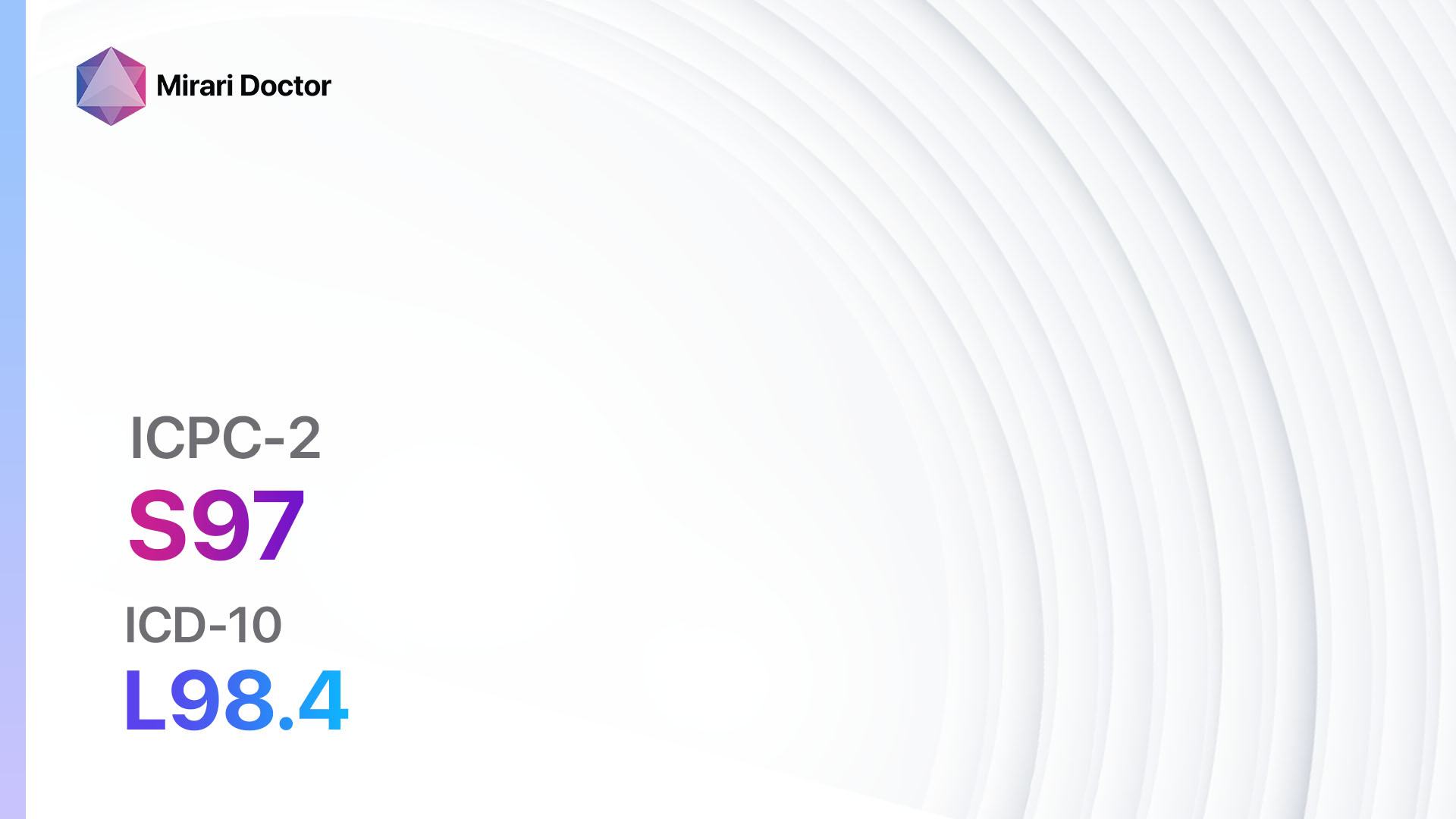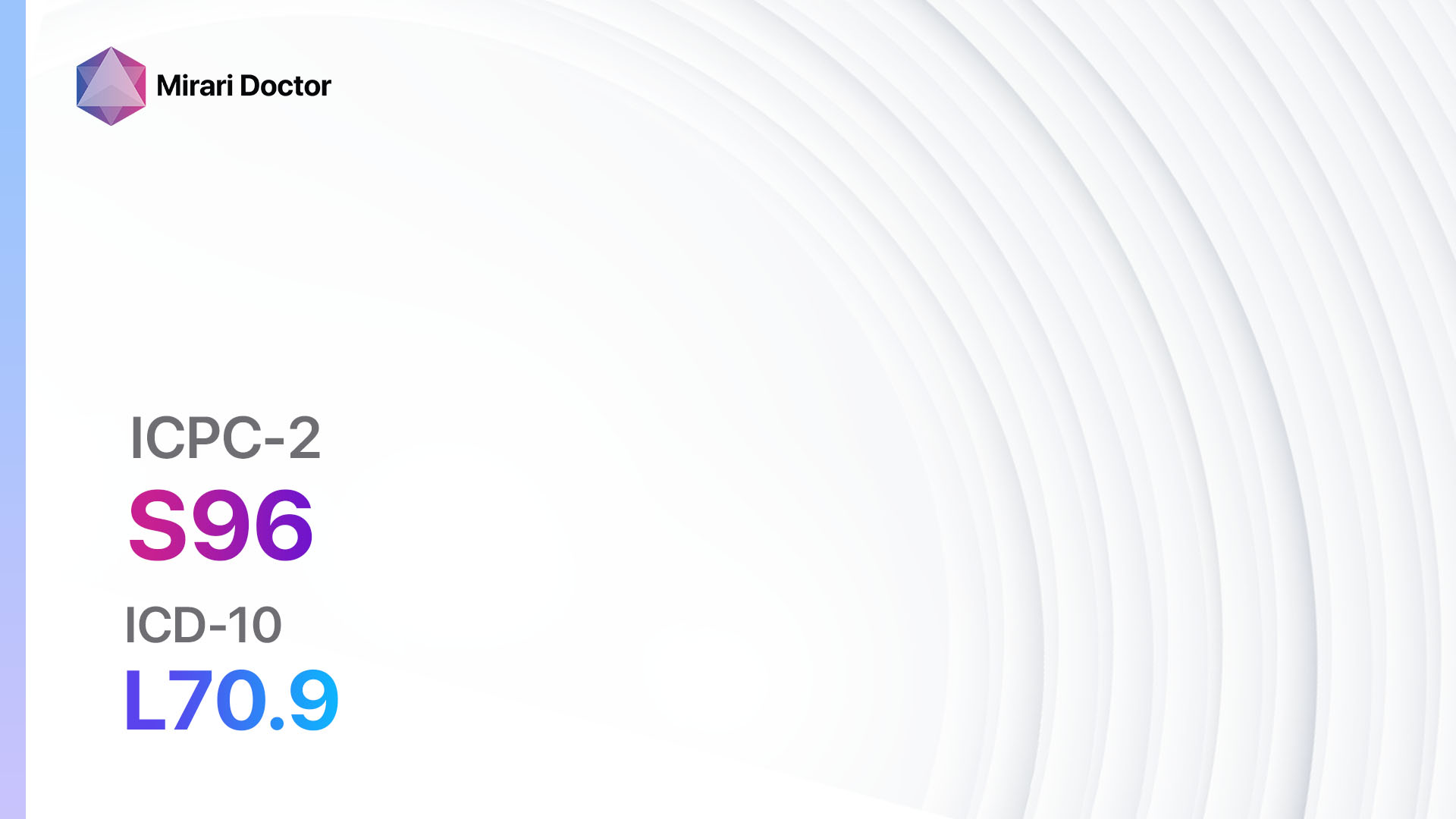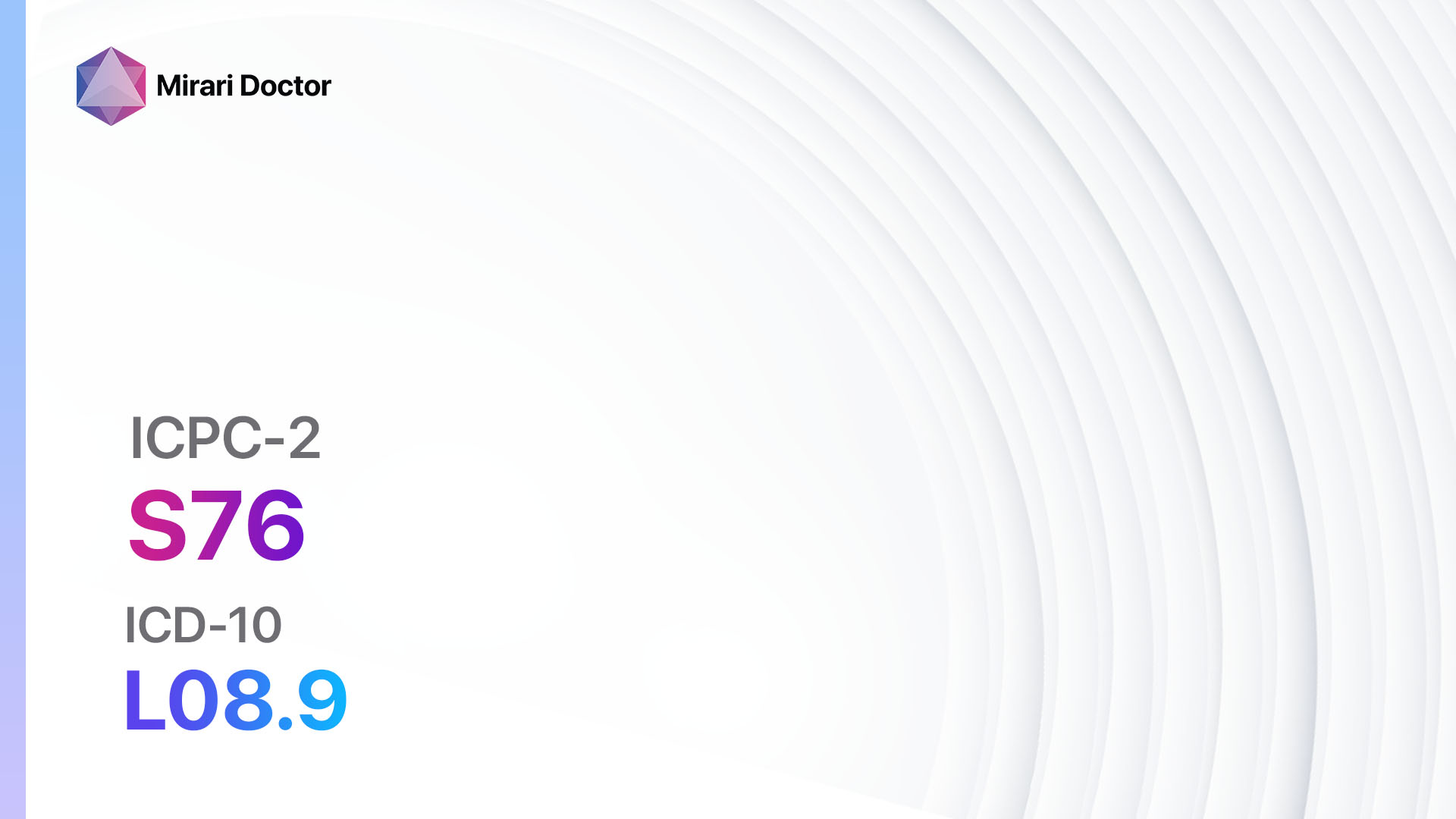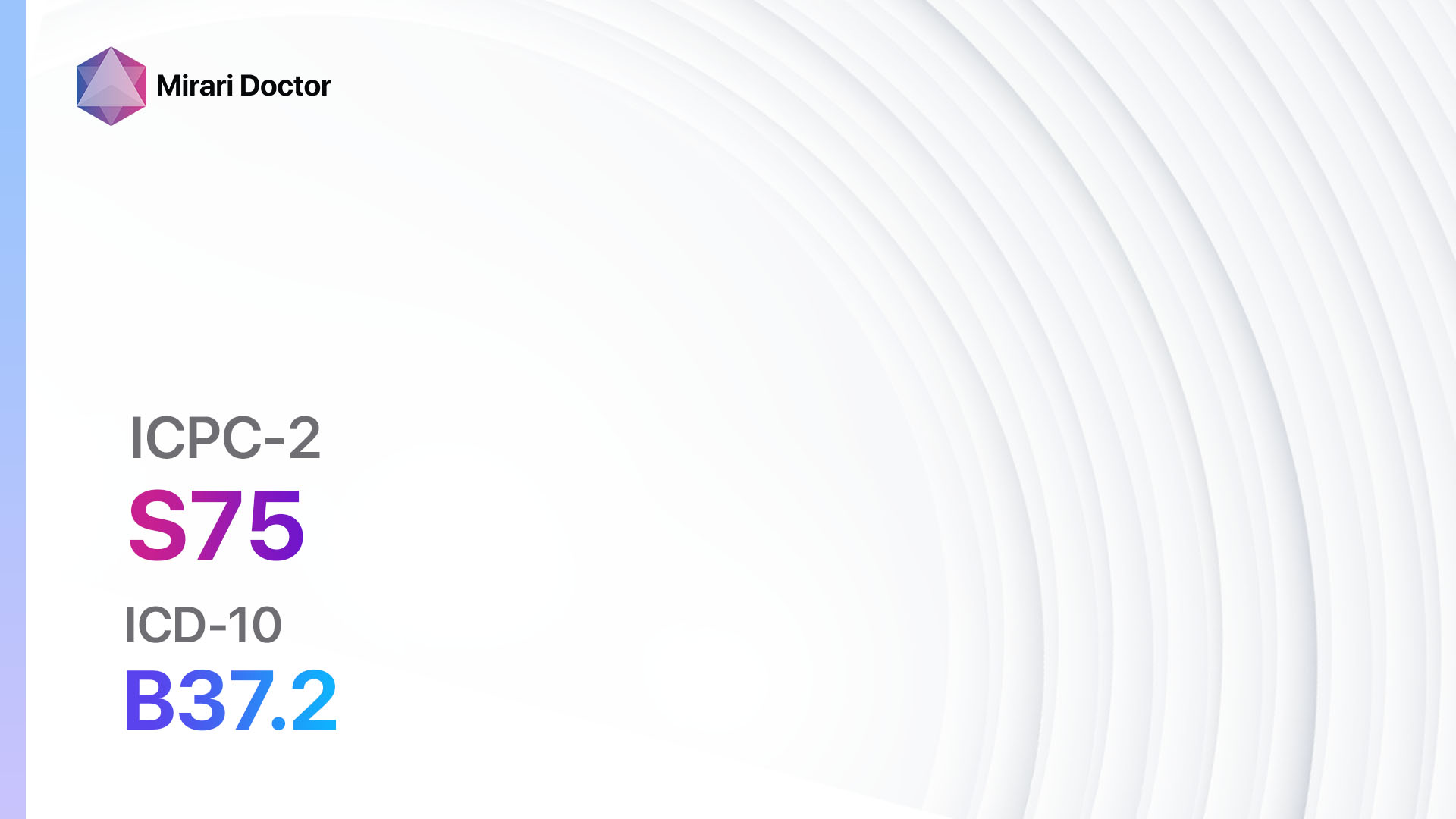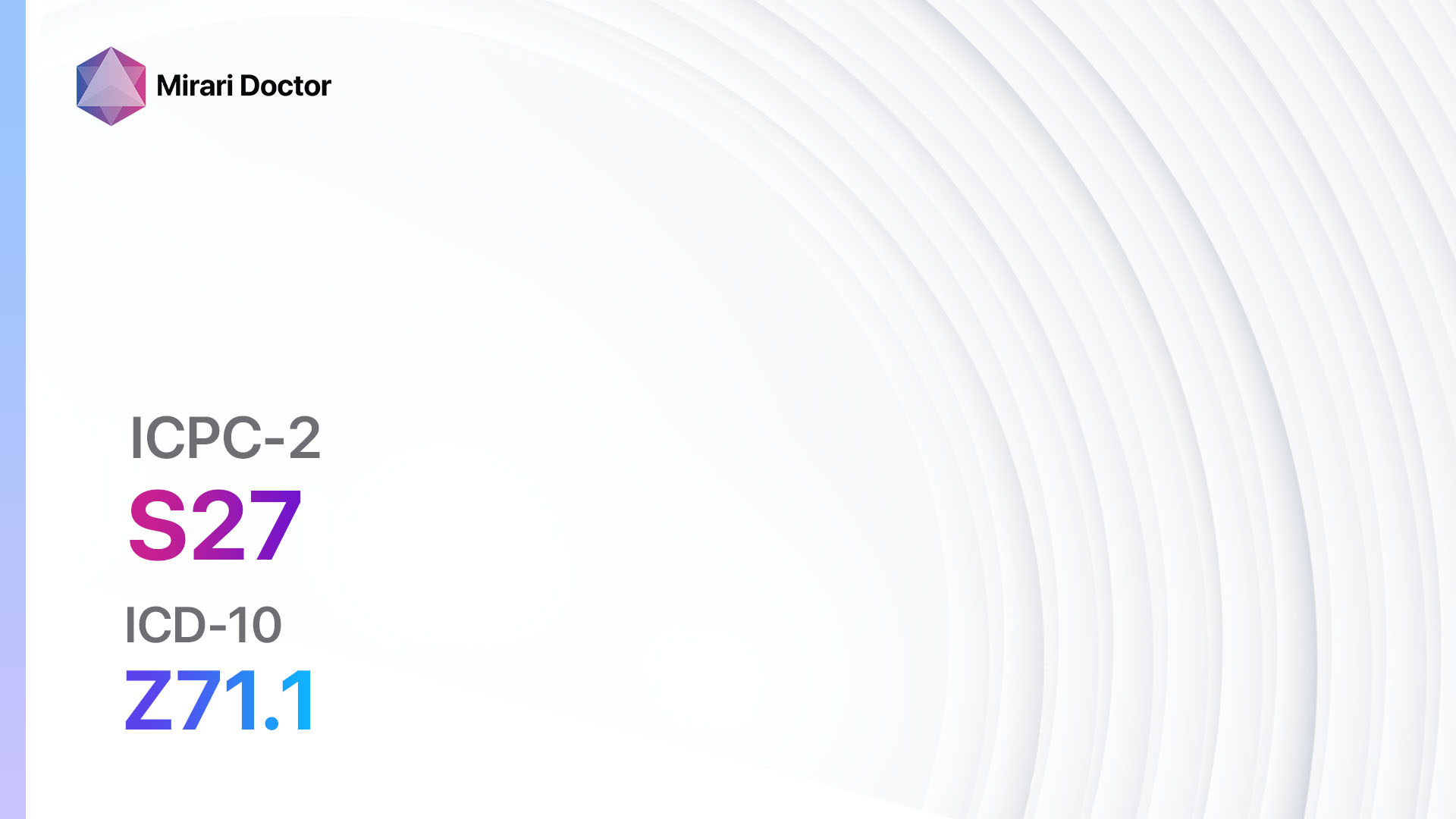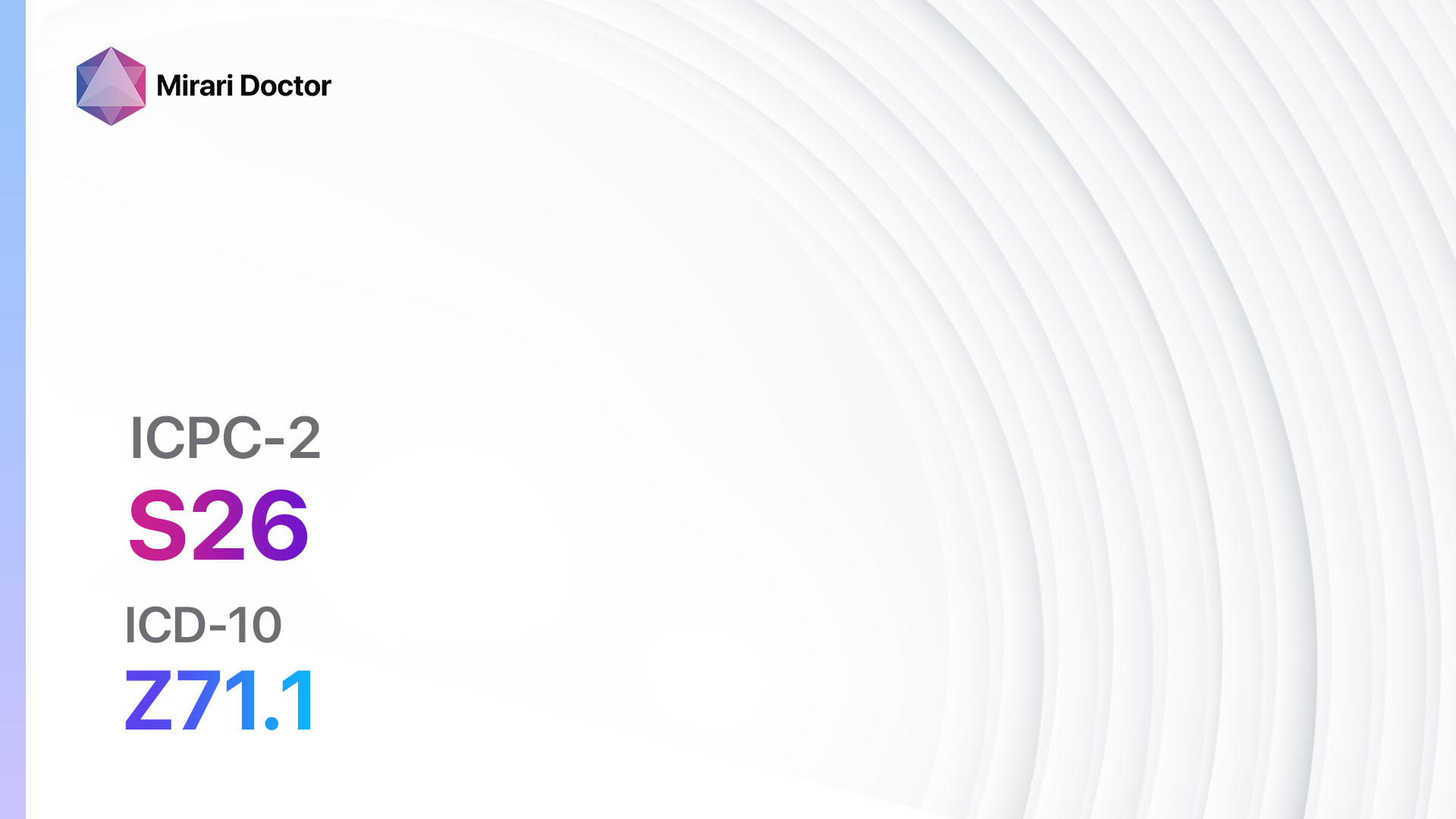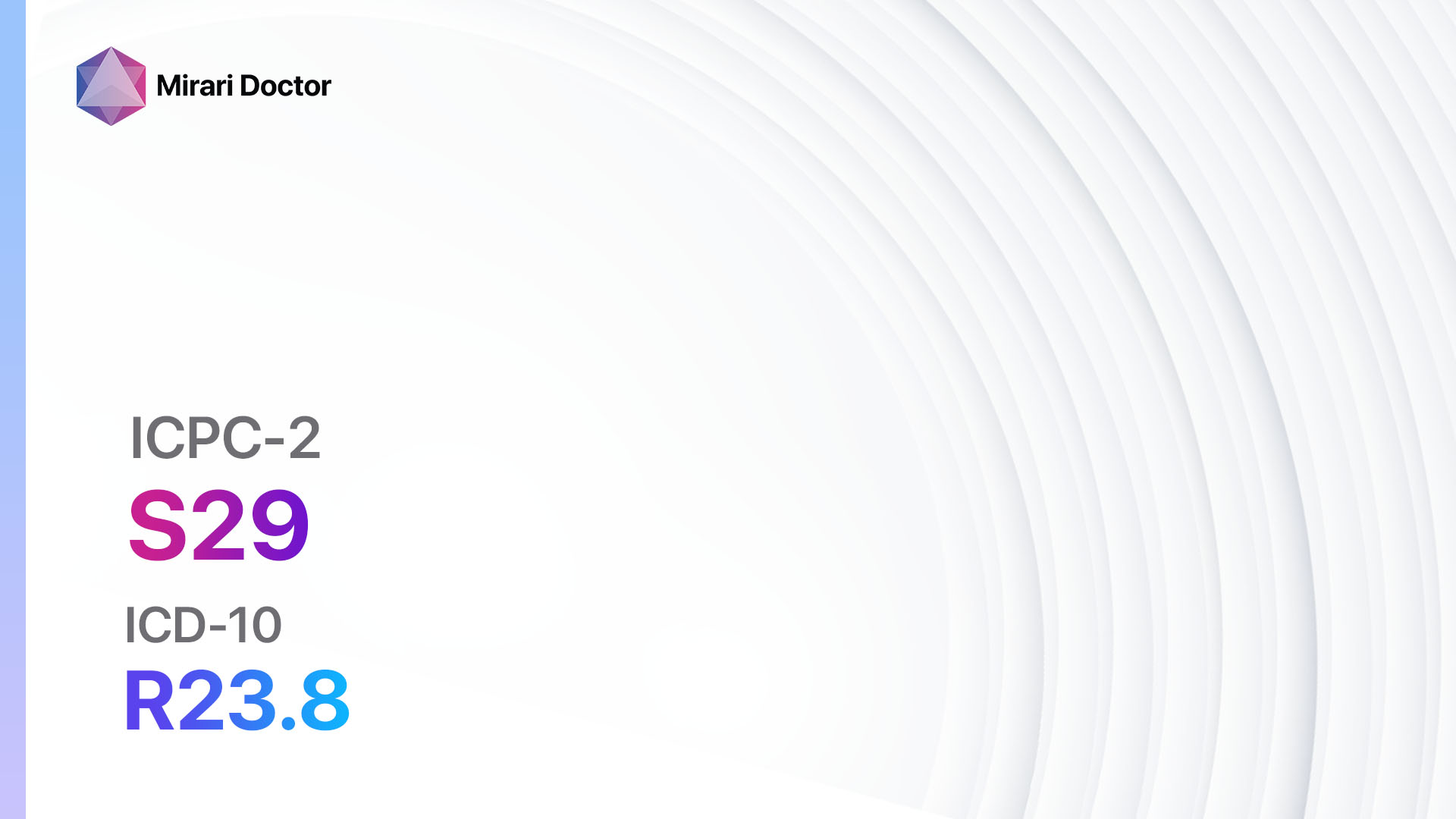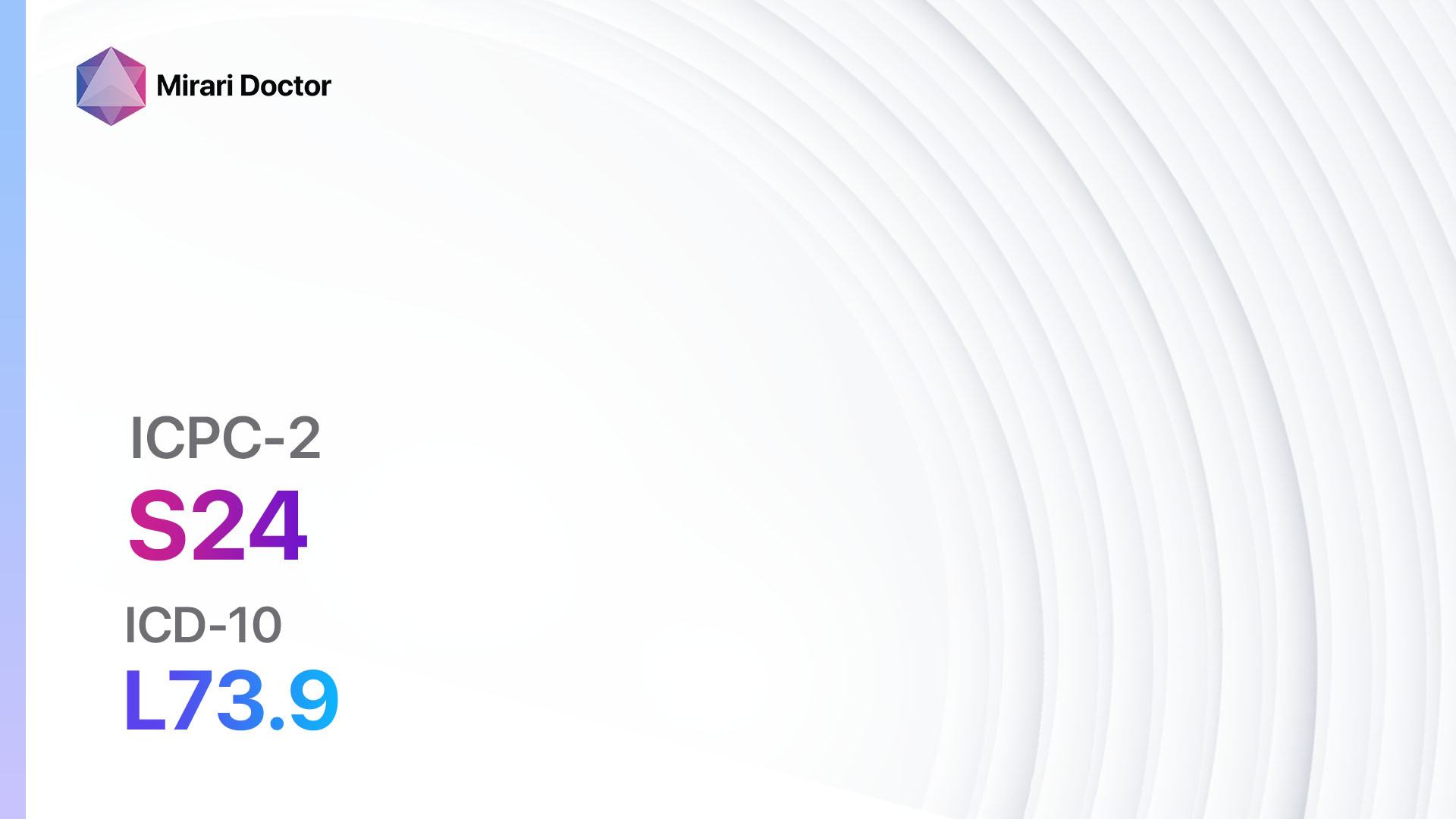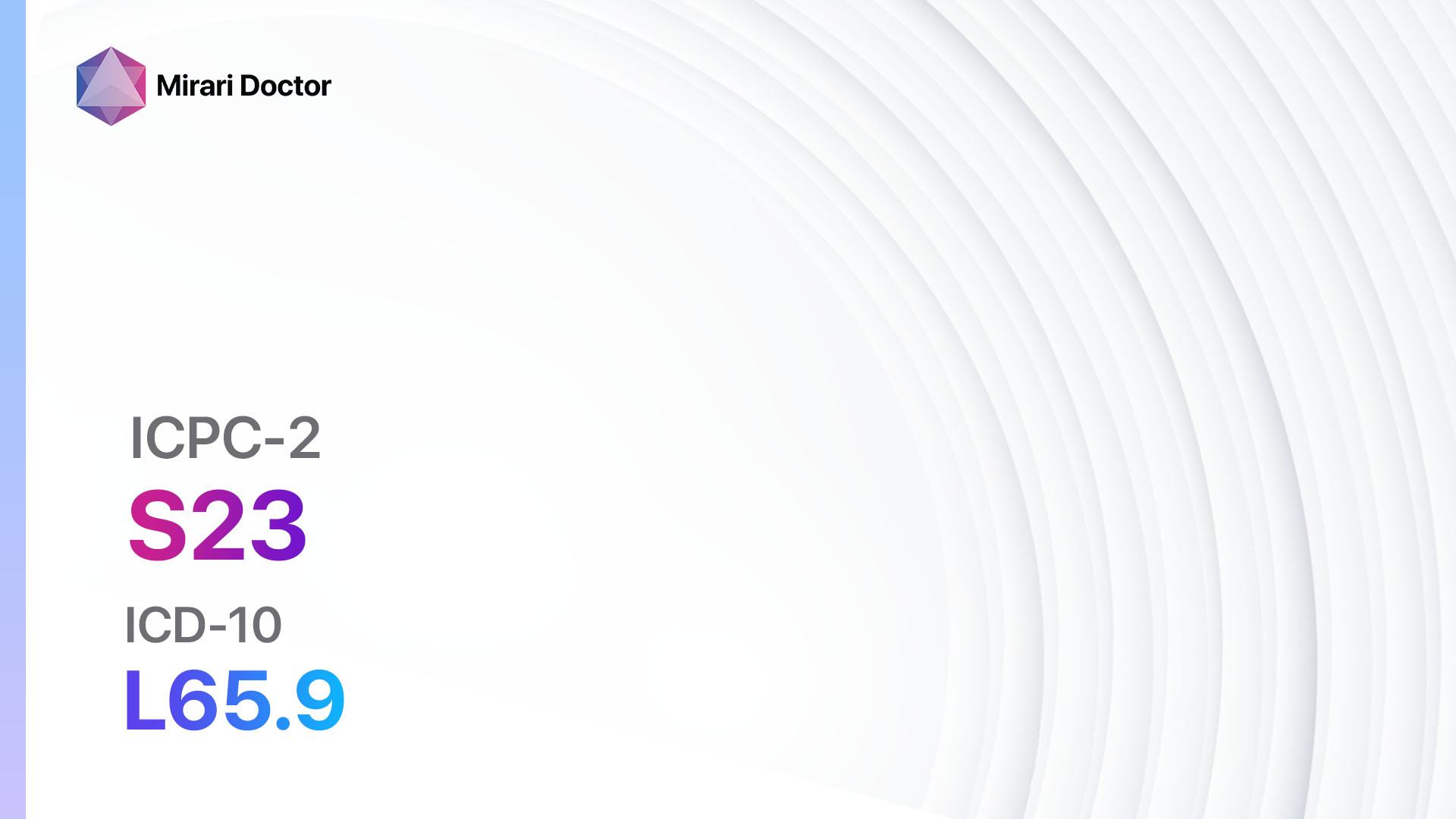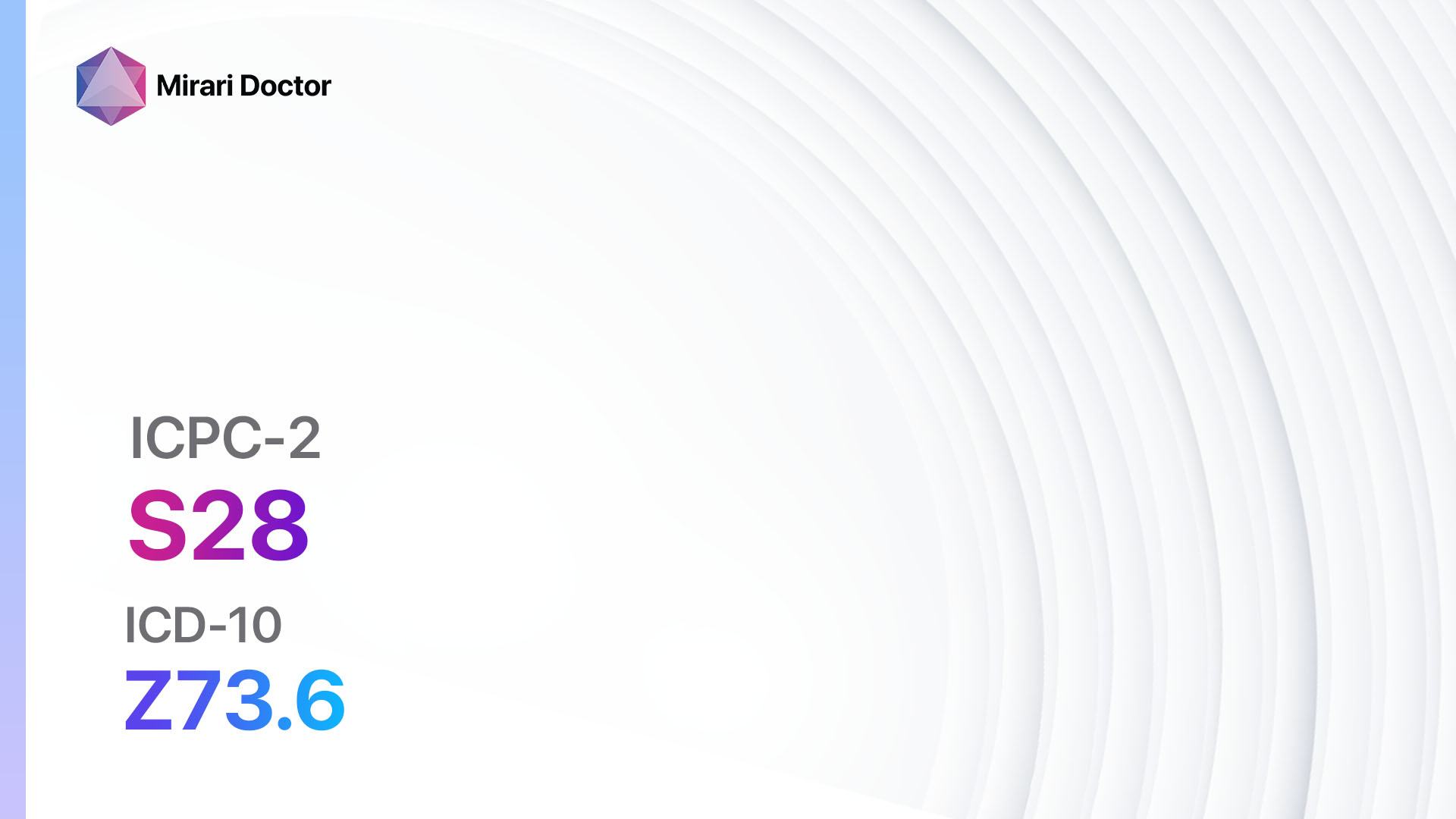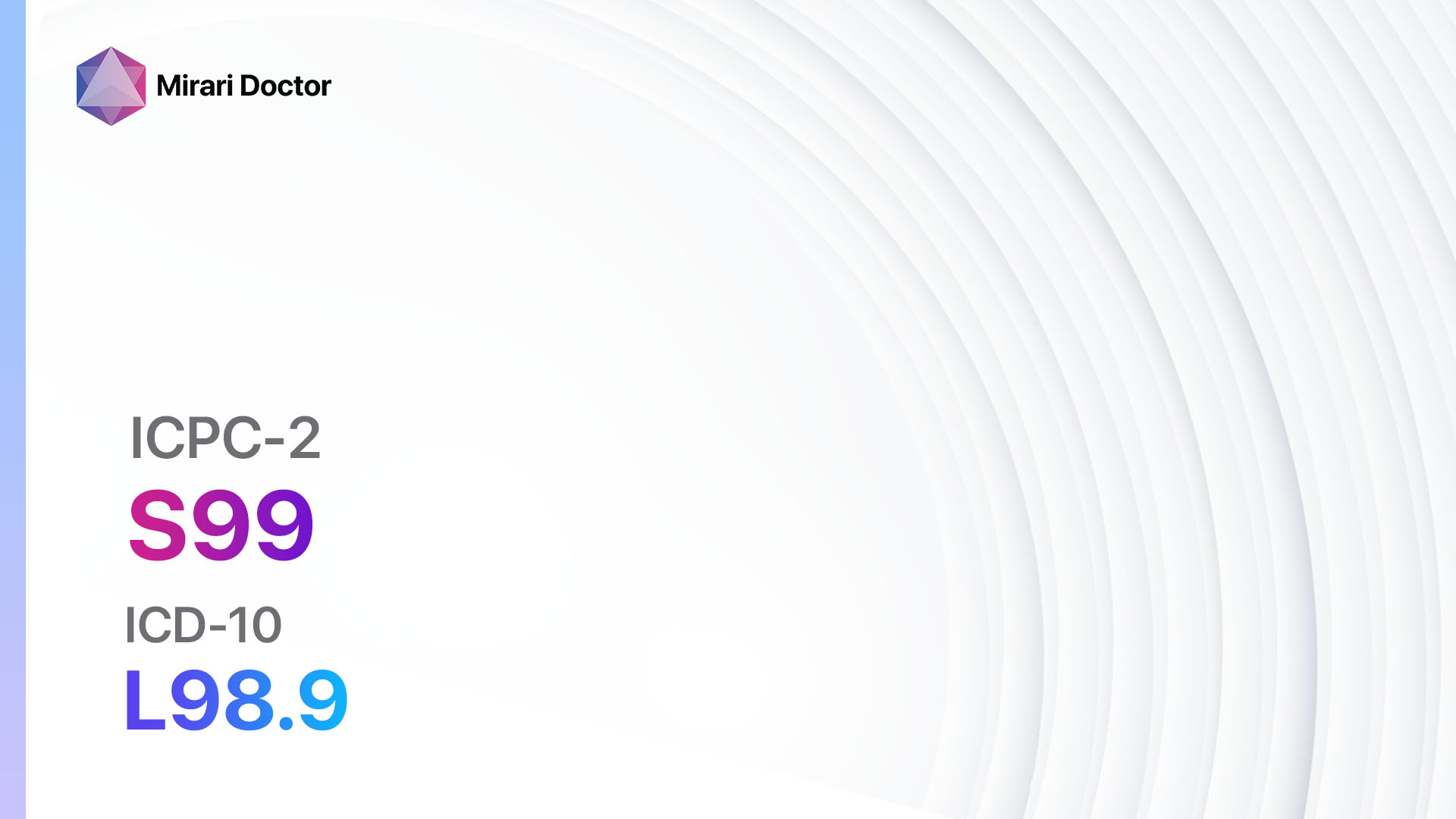
Introduction
Skin diseases encompass a wide range of conditions that affect the skin, including infections, inflammatory disorders, and neoplastic growths[1]. Skin disease, other (ICPC-2: S99) refers to skin conditions that do not fall into specific categories[2]. This guide aims to provide a comprehensive approach to diagnosing and managing skin diseases that do not have a specific classification.
Codes
- ICPC-2 Code: S99 Skin disease other[3]
- ICD-10 Code: L98.9 Disorder of skin and subcutaneous tissue, unspecified[4]
Symptoms
- tching: Patients may experience persistent itching or pruritus[5].
- Rash: The presence of a rash, which may be localized or generalized[6].
- Skin discoloration: Changes in skin color, such as redness, pallor, or hyperpigmentation[7].
- Lesions: The development of abnormal skin lesions, such as papules, nodules, or plaques[8].
- Scaling: The presence of flaking or scaling of the skin[9].
- Pain: Some skin diseases may cause pain or discomfort[10].
- Swelling: Edema or swelling of the skin may be present in certain conditions.
Causes
- Allergies: Skin diseases can be caused by allergic reactions to certain substances, such as medications, cosmetics, or environmental triggers.
- Infections: Bacterial, viral, fungal, or parasitic infections can lead to various skin diseases.
- Autoimmune disorders: Conditions like psoriasis and lupus can cause skin manifestations.
- Genetic factors: Some skin diseases have a genetic component, such as eczema or ichthyosis.
- Environmental factors: Exposure to certain chemicals, irritants, or ultraviolet radiation can contribute to the development of skin diseases.
Diagnostic Steps
Medical History
- Gather information about the patient’s symptoms, including the onset, duration, and progression of the skin disease.
- Identify any potential triggers or exposures that may have contributed to the development of the condition.
- Assess the patient’s medical history, including any previous skin diseases, allergies, or autoimmune disorders.
- Inquire about family history of skin diseases or other relevant genetic conditions.
Physical Examination
- Perform a thorough examination of the skin, including all affected areas.
- Note the characteristics of any skin lesions, such as size, shape, color, texture, and distribution.
- Assess for signs of inflammation, infection, or other abnormalities.
- Examine the nails, hair, and mucous membranes for any associated findings.
- Palpate the skin to evaluate for tenderness, warmth, or induration.
Determine Severity
- Classify the skin disease based on severity and depth, if applicable.
- Mild: Minimal symptoms and limited involvement of the skin.
- Moderate: Moderate symptoms and involvement of a larger area of the skin.
- Severe: Severe symptoms and extensive involvement of the skin, potentially affecting daily activities.
Laboratory Tests
- Blood tests: Complete blood count (CBC), erythrocyte sedimentation rate (ESR), C-reactive protein (CRP), and autoimmune markers may be helpful in diagnosing certain skin diseases.
- Skin biopsy: A sample of the affected skin may be taken for histopathological examination to confirm the diagnosis.
- Allergy testing: Patch testing or blood tests can help identify specific allergens that may be triggering the skin disease.
- Microbiological cultures: Swabs or samples may be taken from skin lesions to identify the causative organism in cases of suspected infection.
Diagnostic Imaging
- In most cases, diagnostic imaging is not necessary for the diagnosis of skin diseases. However, in certain situations, imaging modalities such as X-rays, ultrasound, CT scans, or MRIs may be used to assess deeper structures or evaluate for complications.
Other Tests
- Wood’s lamp examination: This test uses ultraviolet light to identify certain skin conditions, such as fungal infections or pigmentary disorders.
- Dermoscopy: A handheld device with magnification and light can be used to examine skin lesions more closely, aiding in the diagnosis of melanoma or other pigmented lesions.
- Patch testing: This test involves applying small amounts of potential allergens to the skin to identify specific triggers in cases of suspected allergic contact dermatitis.
Follow-up and Patient Education
- Schedule follow-up appointments to monitor the progress of the skin disease and adjust treatment as needed.
- Provide education to the patient about the nature of their skin disease, including triggers, management strategies, and potential complications.
- Encourage the patient to practice good skin hygiene and follow any prescribed treatment regimens.
- Address any concerns or questions the patient may have regarding their condition.
Possible Interventions
Traditional Interventions
Medications:
Top 5 drugs for Skin disease, other (ICPC-2: S99):
- Topical corticosteroids (e.g., hydrocortisone, betamethasone):
- Cost: Generic versions can range from $5 to $50 per tube.
- Contraindications: Active bacterial, viral, or fungal infections.
- Side effects: Skin thinning, discoloration, or irritation.
- Severe side effects: Systemic absorption leading to adrenal suppression or Cushing’s syndrome.
- Drug interactions: None significant.
- Warning: Prolonged use should be avoided, especially on the face or in skin folds.
- Topical calcineurin inhibitors (e.g., tacrolimus, pimecrolimus):
- Cost: Generic versions can range from $50 to $200 per tube.
- Contraindications: Active bacterial, viral, or fungal infections.
- Side effects: Burning or stinging sensation at the application site.
- Severe side effects: None significant.
- Drug interactions: None significant.
- Warning: Long-term safety is still being studied, and a black box warning exists for potential malignancy risk.
- Antihistamines (e.g., cetirizine, loratadine):
- Cost: Generic versions can range from $5 to $20 per month.
- Contraindications: None significant.
- Side effects: Drowsiness, dry mouth.
- Severe side effects: None significant.
- Drug interactions: Sedatives, alcohol.
- Warning: May cause drowsiness, so caution should be exercised when driving or operating machinery.
- Topical antimicrobials (e.g., mupirocin, clotrimazole):
- Cost: Generic versions can range from $5 to $20 per tube.
- Contraindications: None significant.
- Side effects: Local skin irritation.
- Severe side effects: None significant.
- Drug interactions: None significant.
- Warning: Should be used as directed and for the prescribed duration.
- Systemic antibiotics (e.g., doxycycline, cephalexin):
- Cost: Generic versions can range from $10 to $50 per month.
- Contraindications: Allergy to the specific antibiotic.
- Side effects: Gastrointestinal upset, photosensitivity.
- Severe side effects: Severe allergic reactions, Clostridium difficile infection.
- Drug interactions: Oral contraceptives, anticoagulants.
- Warning: Completion of the full course of antibiotics is essential to prevent antibiotic resistance.
Alternative Drugs:
- Immunomodulators (e.g., methotrexate, cyclosporine): Used for severe or refractory cases of skin diseases.
- Biologic agents (e.g., adalimumab, ustekinumab): Reserved for specific skin diseases with an autoimmune component.
- Phototherapy (e.g., narrowband UVB, psoralen plus UVA): Light-based treatments that can be effective for certain skin diseases.
- Retinoids (e.g., isotretinoin, acitretin): Used for severe acne or psoriasis.
Surgical Procedures:
- In some cases, surgical intervention may be necessary for the management of skin diseases, such as excision of skin lesions or Mohs micrographic surgery for skin cancer. The cost of these procedures can vary significantly depending on the complexity and location of the surgery.
Alternative Interventions
- Acupuncture: May help alleviate symptoms and promote overall well-being. Cost: $60-$120 per session.
- Herbal supplements: Certain herbs, such as aloe vera or tea tree oil, may have potential benefits for certain skin conditions. Cost: Varies depending on the specific supplement.
- Dietary modifications: Some individuals may find relief from certain skin diseases by avoiding trigger foods or following specific diets, such as gluten-free or dairy-free. Cost: Varies depending on individual food choices.
- Stress management techniques: Stress can exacerbate certain skin diseases, so practices like meditation, yoga, or relaxation exercises may be beneficial. Cost: Varies depending on the chosen method.
Lifestyle Interventions
- Skin hygiene: Proper cleansing and moisturizing techniques can help manage and prevent skin diseases. Cost: Varies depending on the chosen products.
- Avoidance of triggers: Identifying and avoiding triggers, such as certain fabrics, soaps, or environmental factors, can help prevent flare-ups. Cost: Varies depending on individual circumstances.
- Sun protection: Regular use of sunscreen and protective clothing can help prevent sun-related skin diseases. Cost: Varies depending on the chosen products.
- Healthy lifestyle: Maintaining a balanced diet, regular exercise, and adequate sleep can contribute to overall skin health. Cost: Varies depending on individual choices.
It is important to note that the cost ranges provided are approximate and may vary depending on the location and availability of the interventions. It is recommended to consult with a healthcare professional for personalized treatment options and cost estimates.
Mirari Cold Plasma Alternative Intervention
Understanding Mirari Cold Plasma
- Safe and Non-Invasive Treatment: Mirari Cold Plasma is a safe and non-invasive treatment option for various skin conditions. It does not require incisions, minimizing the risk of scarring, bleeding, or tissue damage.
- Efficient Extraction of Foreign Bodies: Mirari Cold Plasma facilitates the removal of foreign bodies from the skin by degrading and dissociating organic matter, allowing easier access and extraction.
- Pain Reduction and Comfort: Mirari Cold Plasma has a local analgesic effect, providing pain relief during the treatment, making it more comfortable for the patient.
- Reduced Risk of Infection: Mirari Cold Plasma has antimicrobial properties, effectively killing bacteria and reducing the risk of infection.
- Accelerated Healing and Minimal Scarring: Mirari Cold Plasma stimulates wound healing and tissue regeneration, reducing healing time and minimizing the formation of scars.
Mirari Cold Plasma Prescription
Video instructions for using Mirari Cold Plasma Device – S99 Skin disease other (ICD-10:L98.9)
| Mild | Moderate | Severe |
| Mode setting: 1 (Infection) Location: 0 (Localized) Morning: 15 minutes, Evening: 15 minutes |
Mode setting: 1 (Infection) Location: 0 (Localized) Morning: 30 minutes, Lunch: 30 minutes, Evening: 30 minutes |
Mode setting: 1 (Infection) Location: 0 (Localized) Morning: 30 minutes, Lunch: 30 minutes, Evening: 30 minutes |
| Mode setting: 2 (Wound Healing) Location: 0 (Localized) Morning: 15 minutes, Evening: 15 minutes |
Mode setting: 2 (Wound Healing) Location: 0 (Localized) Morning: 30 minutes, Lunch: 30 minutes, Evening: 30 minutes |
Mode setting: 2 (Wound Healing) Location: 0 (Localized) Morning: 30 minutes, Lunch: 30 minutes, Evening: 30 minutes |
| Total Morning: 30 minutes approx. $5 USD, Evening: 30 minutes approx. $5 USD |
Total Morning: 60 minutes approx. $10 USD, Lunch: 60 minutes approx. $10 USD, Evening: 60 minutes approx. $10 USD, |
Total Morning: 60 minutes approx. $10 USD, Lunch: 60 minutes approx. $10 USD, Evening: 60 minutes approx. $10 USD, |
| Usual treatment for 7-60 days approx. $70 USD – $600 USD | Usual treatment for 6-8 weeks approx. $1,260 USD – $1,680 USD |
Usual treatment for 3-6 months approx. $2,700 USD – $5,400 USD
|
 |
|
Use the Mirari Cold Plasma device to treat Skin disease, other effectively.
WARNING: MIRARI COLD PLASMA IS DESIGNED FOR THE HUMAN BODY WITHOUT ANY ARTIFICIAL OR THIRD PARTY PRODUCTS. USE OF OTHER PRODUCTS IN COMBINATION WITH MIRARI COLD PLASMA MAY CAUSE UNPREDICTABLE EFFECTS, HARM OR INJURY. PLEASE CONSULT A MEDICAL PROFESSIONAL BEFORE COMBINING ANY OTHER PRODUCTS WITH USE OF MIRARI.
Step 1: Cleanse the Skin
- Start by cleaning the affected area of the skin with a gentle cleanser or mild soap and water. Gently pat the area dry with a clean towel.
Step 2: Prepare the Mirari Cold Plasma device
- Ensure that the Mirari Cold Plasma device is fully charged or has fresh batteries as per the manufacturer’s instructions. Make sure the device is clean and in good working condition.
- Switch on the Mirari device using the power button or by following the specific instructions provided with the device.
- Some Mirari devices may have adjustable settings for intensity or treatment duration. Follow the manufacturer’s instructions to select the appropriate settings based on your needs and the recommended guidelines.
Step 3: Apply the Device
- Place the Mirari device in direct contact with the affected area of the skin. Gently glide or hold the device over the skin surface, ensuring even coverage of the area experiencing.
- Slowly move the Mirari device in a circular motion or follow a specific pattern as indicated in the user manual. This helps ensure thorough treatment coverage.
Step 4: Monitor and Assess:
- Keep track of your progress and evaluate the effectiveness of the Mirari device in managing your Skin disease, other. If you have any concerns or notice any adverse reactions, consult with your health care professional.
Note
This guide is for informational purposes only and should not replace the advice of a medical professional. Always consult with your healthcare provider or a qualified medical professional for personal advice, diagnosis, or treatment. Do not solely rely on the information presented here for decisions about your health. Use of this information is at your own risk. The authors of this guide, nor any associated entities or platforms, are not responsible for any potential adverse effects or outcomes based on the content.
Mirari Cold Plasma System Disclaimer
- Purpose: The Mirari Cold Plasma System is a Class 2 medical device designed for use by trained healthcare professionals. It is registered for use in Thailand and Vietnam. It is not intended for use outside of these locations.
- Informational Use: The content and information provided with the device are for educational and informational purposes only. They are not a substitute for professional medical advice or care.
- Variable Outcomes: While the device is approved for specific uses, individual outcomes can differ. We do not assert or guarantee specific medical outcomes.
- Consultation: Prior to utilizing the device or making decisions based on its content, it is essential to consult with a Certified Mirari Tele-Therapist and your medical healthcare provider regarding specific protocols.
- Liability: By using this device, users are acknowledging and accepting all potential risks. Neither the manufacturer nor the distributor will be held accountable for any adverse reactions, injuries, or damages stemming from its use.
- Geographical Availability: This device has received approval for designated purposes by the Thai and Vietnam FDA. As of now, outside of Thailand and Vietnam, the Mirari Cold Plasma System is not available for purchase or use.
References
- Bolognia, J. L., Schaffer, J. V., & Cerroni, L. (2018). Dermatology (4th ed.). Elsevier.
- WONCA International Classification Committee. (2005). ICPC-2: International Classification of Primary Care (2nd ed.). Oxford University Press.
- World Health Organization. (2019). International Statistical Classification of Diseases and Related Health Problems (11th ed.).
- Yosipovitch, G., & Bernhard, J. D. (2013). Chronic pruritus. New England Journal of Medicine, 368(17), 1625-1634.
- Marks, J. G., & Miller, J. J. (2019). Lookingbill and Marks’ Principles of Dermatology (6th ed.). Elsevier.
- Wolff, K., Johnson, R. A., Saavedra, A. P., & Roh, E. K. (2017). Fitzpatrick’s Color Atlas and Synopsis of Clinical Dermatology (8th ed.). McGraw-Hill Education.
- James, W. D., Elston, D. M., Treat, J. R., Rosenbach, M. A., & Neuhaus, I. M. (2020). Andrews’ Diseases of the Skin: Clinical Dermatology (13th ed.). Elsevier.
- Griffiths, C., Barker, J., Bleiker, T., Chalmers, R., & Creamer, D. (Eds.). (2016). Rook’s Textbook of Dermatology (9th ed.). Wiley-Blackwell.
- Goldsmith, L. A., Katz, S. I., Gilchrest, B. A., Paller, A. S., Leffell, D. J., & Wolff, K. (Eds.). (2012). Fitzpatrick’s Dermatology in General Medicine (8th ed.). McGraw-Hill.
- Marghoob, A. A., Malvehy, J., & Braun, R. P. (Eds.). (2012). Atlas of Dermoscopy (2nd ed.). CRC Press.
Related articles
Made in USA


